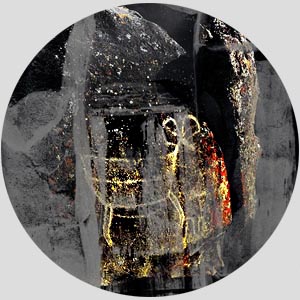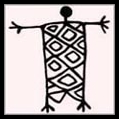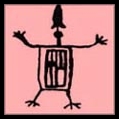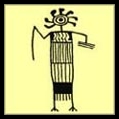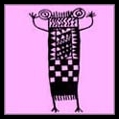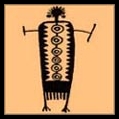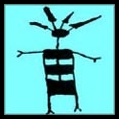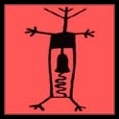The Lost Way of Stones
Joel Weishaus
These sheep dreamers were especially adept at charming game animals. Hence, these were shamans of the hunt." (1)
The Lost Way of Stones is built around indigenous rock art found in Southern California, including that of the Chumash Indians who lived mainly along the Santa Barbara Channel; and art made by Shoshonean peoples that is located on the Naval Air Weapons Station, near Death Valley, CA., where, contrasting human creativity with its destructive shadow, it is "one of the most spectacular concentrations of rock art sites in North America."(2)
Polychrome and monochrome pictographs were painted onto sandstone, pectroglyphs tapped into dark basalt, art and nature exchanging minerals and patinas of meaning. Archaeologists argue over interpretation; but like the Philosopher's Stone, which does not "allow itself to be held in meaning,"(3) there is no single resolution, only turning and re-turning.
My study of Amerindian rock art began during my tenure at the University of New Mexico's Center for Southwest Research. Cataloging slides of rock art of the Southwest also whet my interest in Aurignacian cave art. While the work discovered in the caves reveals a high level of aesthetic sophistication that must have been developing over millennia, most rock art, examples of which are found in over 160 countries, while usually technically cruder are more symbolically varied and culturally evocative. Here Homo sapiens entered the picture, living and creating, naturally and supernaturally, their cultures and themselves. "Thus, all the fine points of human psychology end by expressing themselves in insentient rock. Human legend thus finds its illustrations in inanimate nature, as if stone were inscribed through a natural process. This would make poets our first paleographers—and matter itself profoundly legendary."(4)
During the thousands of years before being rediscovered, cave art was protected because the caves, arduous to negotiate, weren't lived in, but probably accessed only for special occasions, such as initiations into the numinous world. What was perhaps the most sacred art was made in the deepest interior. Eventually abandoned and forgotten, their entrances were hidden behind foliage and debris.
On the other hand, for him the hoped-for purpose, the sacred task, of painting was to tune in to the invisible—rather in the same manner an anatomical diagram tunes in to the invisible functioning of a living body. And why did he want to do this? Because rock art is continuously exposed to weathering, and protected from vandalism only by the difficulty of reaching it. Archaeologist Paul Bahn writes that "it was the process of journeying to a location and leaving an image there which counted, rather than the image itself, its appearance, degree of completeness, or durability."(5) However, I would argue that the journey taken and the efficiency of the images made are entangled.
So this is where I arrived, knowing that this place is not a unique place, but that all places are inclusive of countless other places.
In addition to the scientific practice of archaeology, Christine Finn suggests that "a poetic interpretation of archaeology—and by that I mean one that moves into the metaphysical to consider the essence of a 'thing'—should be included in the armory of interpretative tools available to the archaeologist."(6)
As for how digital literary art might relate to archaeological discourse, British archaeologist Christopher Tilley takes a relevant course:
First we can experiment with organisation of the text itself — the manner in which we inscribe words and statements on to a page. Second we can attempt to break the types of power relation set up between the writer and the reader in texts as constituted at present by attempting to write 'producer' as opposed to 'consumer' texts. Third we can self-reflexively examine ourselves, our subjectivity as writers in the texts that we produce.( 7)
Here the page is a panel, the relationship between writer and reader is open to communication, and the artist works in a self-reflective environment of meditation, research and redaction.
Beginning with a vision of 80 panels, I soon realized that both texts and images request what media critic N. Katherine Hayles calls "deep attention," as opposed to "hyper attention (which) excels at negotiating rapidly changing environments in which multiple foci compete for attention; its disadvantage is impatience with focusing for long periods of time on a noninteractive object..."(8)
Each of the eight "patterned body anthropomorphs" below links to five panels, making a total of 40 texts juxtaposed with 40 palimpsests. There are also references and, as seen above, my trope of invagination, "a fragment of text planted within the paragraphic body, interrupting its continuity and disturbing its literal meaning," is also in play.(9)
The Lost Way of Stones seeks to contribute to rock art studies what, because of specialization, most archaeologists cannot. Proceeding from the assumption that all honest endeavors add to our knowledge of who we are, thus, who we may someday be, this work can only begin to explore the vast range of research and scholarship being generated in rock art studies and accordant fields.
Panels 1-5
Panels 16-20
Panels 21-25
Panels 26-30Panels 31-35
Panels 36-40
1- A.P. Garfinkel, D.R. Austin, D. Earle and H. Williams (Wokod), “Myth, Ritual and Rock Art: Coso Decorated Animal-Humans and the Animal Master.” May 19, 2009.
http://www.petroglyphs.us/article_myth_ritual_and_rock_art.htm
2- D.S. Whitley, A Guide to Rock Art Sites: Southern California and Southern Nevada. Missoula: Mountain Press Publishing, 2001.
3- J.Hillman, "Concerning the Stone: Alchemical Images of the Gold." Sphinx 5 (1993).
for him the hoped-for purpose: J. Berger, “Seeing Through Lies: Jean-Michel Basquiat, Saboteur." Harper’s Magazine, April, 2011.
4- G. Bachelard, Earth and Reveries of Will. Dallas: Dallas Institute Publications, 2002.
5- P.G. Bahn, Prehistoric Rock Art: Polemics and Progress. Cambridge, UK: Cambridge University Press, 2010.
6- C.A. Finn, "Poetry and Archaeology." In, J.H. Jameson, Jr., J.E. Ehrenhard and C.A. Finn, Editors, Ancient Muses: Archaeology and the Arts. Tuscaloosa: University of Alabama Press, 2003.
7- C. Tilley, “On Modernity and Archaeological Discourse.” http://archaeology.kiev.ua/meta/tilley.html
8- N.K. Hayles, "Hyper and Deep Attention: The Generational Divide in Cognitive Modes." Profession, 2007.
9- J. Weishaus, "The Gateless Gate." http://www.cddc.vt.edu/host/weishaus/Gate-R/Intro-R.htm
The Lost Way of Stones is dedicated to those ancient unknown artists whose work exemplifies the best of us all.
Thank you to:
My wife, Susan Rowland, for her love, encouragement, insightful critiques.
Ginette Paris, for the generous loan of her home: where this project began.
Alan Liu, and The University of California, Santa Barbara, for their fellowship.
Karl Kempton, who provided valuable research and the spirit of the place.
As always, there are many others I wish to thank.You know who you are.Joel Weishaus,
Carpinteria, CA.
7/2011- 4/2012
